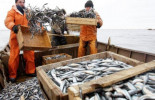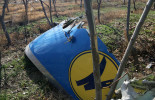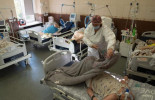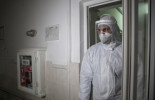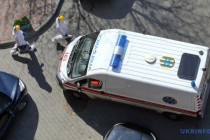 Ukraine reports 5,276 new COVID-19 cases
Ukraine reports 5,276 new COVID-19 cases
 Zelensky: Every third Ukrainian considers road construction one of greatest achievements of 2021
Zelensky: Every third Ukrainian considers road construction one of greatest achievements of 2021
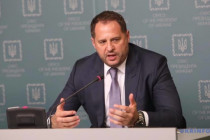 Ukraine ready to implement Minsk agreements, but Russia's desire needed - Yermak
Ukraine ready to implement Minsk agreements, but Russia's desire needed - Yermak
 Michel: EU unanimously agree to roll over economic sanctions against Russia
Michel: EU unanimously agree to roll over economic sanctions against Russia
 Actions by Ukraine's partners will help prevent worst-case scenario - Zelensky
Actions by Ukraine's partners will help prevent worst-case scenario - Zelensky
 COVID-19 in Ukraine: Health officials confirm 8,899 daily cases as of Dec 17
COVID-19 in Ukraine: Health officials confirm 8,899 daily cases as of Dec 17
 Macron tells Zelensky he declared support for Ukraine in call with Putin
Macron tells Zelensky he declared support for Ukraine in call with Putin
 Zelensky, Scholz discuss gas transit through Ukraine after 2024
Zelensky, Scholz discuss gas transit through Ukraine after 2024
 Ukraine ready for any format of talks with Russia - Zelensky
Ukraine ready for any format of talks with Russia - Zelensky
 Ukraine’s only journalist in Russia facing extremism charges - lawyer
Ukraine’s only journalist in Russia facing extremism charges - lawyer
 PM Shmyhal: First two applications for investment projects worth $96 million filed
PM Shmyhal: First two applications for investment projects worth $96 million filed
 Zelensky, PM of Italy discuss security situation around Ukraine
Zelensky, PM of Italy discuss security situation around Ukraine
 President signs off State Budget 2022
President signs off State Budget 2022
 London considering all options for responding to Russia's aggression against Ukraine
London considering all options for responding to Russia's aggression against Ukraine
 Putin, Biden to hold another round of talks
Putin, Biden to hold another round of talks
 Some 260,000 Ukrainians “victims of human trafficking” over 30 years - prosecutor general
Some 260,000 Ukrainians “victims of human trafficking” over 30 years - prosecutor general
 Ukraine plans to create center to protect energy infrastructure from cyber attacks
Ukraine plans to create center to protect energy infrastructure from cyber attacks
 No clear idea so far when Normandy Four top diplomats set to meet - German Ambassador
No clear idea so far when Normandy Four top diplomats set to meet - German Ambassador
 Ukraine receives EUR 600M in macro-financial assistance from EU
Ukraine receives EUR 600M in macro-financial assistance from EU
 Zelensky holds phone conversation with PM of Israel
Zelensky holds phone conversation with PM of Israel
 Ukraine sets new daily COVID vaccination record
Ukraine sets new daily COVID vaccination record
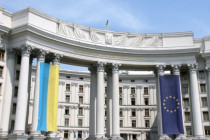 MFA: European Union has not yet removed Ukraine from list of safe countries
MFA: European Union has not yet removed Ukraine from list of safe countries
 Kyiv records 1,023 new COVID-19 cases, 29 deaths
Kyiv records 1,023 new COVID-19 cases, 29 deaths
 G7 ambassadors welcome adoption of law on NABU status
G7 ambassadors welcome adoption of law on NABU status
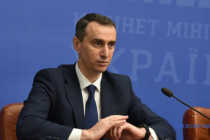 Ukraine can increase Covid vaccination rates to 1.5M a week – Liashko
Ukraine can increase Covid vaccination rates to 1.5M a week – Liashko
The operator of Japan's Fukushima nuclear plant has begun removing nuclear fuel from one of the reactors that melted down after the devastating 2011 earthquake and tsunami.
Remotely controlled equipment is lifting fuel rods from a storage pool inside reactor number three.
The delicate work at the contaminated site is expected to take two years.
The next phase of the huge clean-up in reactor three will be to remove molten nuclear fuel that remains deep inside.
A spokeswoman for the Tokyo Electric Power Company (Tepco) said the operation to remove the fuel had been delayed by earthquake debris inside the building as well as other technical issues.
Reactor buildings at the Fukushima Daiichi power plant were damaged by hydrogen explosions caused by the earthquake and tsunami. Three reactors melted down.
In the latest operation, more than 500 radioactive cylinders have to be placed in container casks which are then lifted from the flooded compartment and transported by lorry to another pool of water for storage.
Radioactive gases could be released if the cylinders break or are exposed to air.
"We had to proceed carefully and we needed to take measures as dust would waft up and increase radiation readings," spokeswoman Yuka Matsubara told AFP news agency.
The removal of molten nuclear fuel from inside reactor number three is not expected to begin until 2021 and is considered to be the most difficult part of the clean-up.
Tepco says it plans to start removing fuel from reactors one and two, which also melted down, in 2023. In 2014 engineers removed fuel rods from reactor four, which was offline at the time of the tsunami and, although damaged, did not suffer a meltdown.
The latest stage of the massive clean-up comes weeks after an evacuation order for one of two towns near the plant was lifted, allowing residents back for the first time since the disaster.
About 50 people were allowed to return to areas of Okuma, west of the Daiichi plant, after radiation levels were deemed safe.
However, correspondents say radiation remains a major concern for residents and the vast majority of the town's original inhabitants are unlikely to go back.
The disaster at the nuclear power plant, about 62km (39 miles) south-east of the city of Fukushima, forced more than 470,000 people to be evacuated.
Though no-one died as a direct result of the nuclear meltdown, Tepco has paid out compensation to some of those affected.
More than 40 patients had to be evacuated from a hospital in the area and later died, while other deaths have been linked to the trauma suffered by those who lost their homes and loved ones.
In 2017, three former Tepco executives went on trial charged with professional negligence linked to the hospital evacuation.
Nearly 18,500 people were killed or went missing after the 2011 earthquake triggered a massive tsunami.






















































